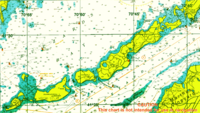Cuttyhunk, Massachusetts

An aerial view of the island
|
|
| Geography | |
|---|---|
| Location | between Buzzards Bay and Vineyard Sound |
| Coordinates | 41°25′8″N 70°56′2″W / 41.41889°N 70.93389°WCoordinates: 41°25′8″N 70°56′2″W / 41.41889°N 70.93389°W |
| Archipelago | Elizabeth Islands |
| Major islands | Penikese Island and Nashawena Island |
| Area | 2.35 km2 (0.91 sq mi) |
| Length | 1.5 mi (2.4 km) |
| Width | .75 mi (1.21 km) |
| Highest elevation | 154 ft (46.9 m) |
| Highest point | Lookout Hill |
| Administration | |
|
United States
|
|
| State | Massachusetts |
| County | Dukes |
| Town | Gosnold |
| Demographics | |
| Population | 52 |
| Pop. density | 23.32 /km2 (60.4 /sq mi) |
| The Elizabeth Islands |
|---|
 |
| Islands listed in order from east to west: |
| Major Islands: |
| Nonamesset Uncatena Naushon Pasque Nashawena Penikese Cuttyhunk |
| Minor Islands: |
| Bachelor Baret Bull Cedar Gosnold Gull Rock Veckatimest Weepecket Islands |
Cuttyhunk Island is the outermost of the Elizabeth Islands in Massachusetts. A small outpost for the harvesting of sassafras was occupied for a few weeks in 1602, arguably making it the first English settlement in New England. Cuttyhunk is located between Buzzards Bay to the north and Vineyard Sound to the south. Penikese Island and Nashawena Island are located to the north and east respectively.
The island has a land area of 580 acres (0.91 sq mi; 2.3 km2), and a population of 52 persons as of the 2000 census. It is the fourth largest in area of the Elizabeth Islands and home to the village of Cuttyhunk. It lies entirely within the town of Gosnold.
Cuttyhunk is about a mile and a half long, and three-quarters of a mile wide, with a large natural harbor at the eastern end of the island. Fully half of the main part of the island is set apart as a nature preserve. It is home to a wide variety of birds such as piping plovers, least terns and Massachusetts' American oystercatchers, as well as White-tailed deer, White-footed mice, and Eastern cottontails. It also has a small population of coyotes. Cuttyhunk has most varieties of New England’s wildflowers, as well as bayberry, sweet peas, and a host of other plant life.
Two large peninsular arms extend from the main body of the island, named Canapitsit (the southern arm) and Copicut Neck (the northern arm). The shore is made up largely of rocks, testimony to Cuttyhunk’s glacial origins. Cuttyhunk is covered with rocks and stones that are elsewhere found only in the mountains of Vermont and New Hampshire.
...
Wikipedia

